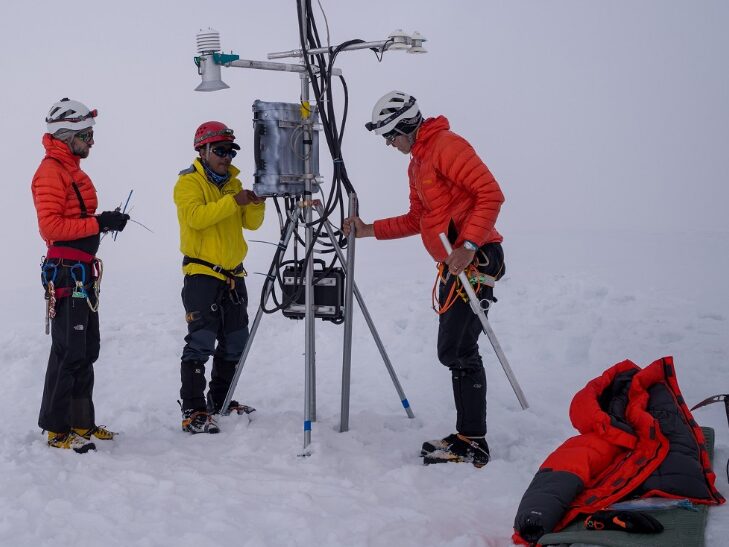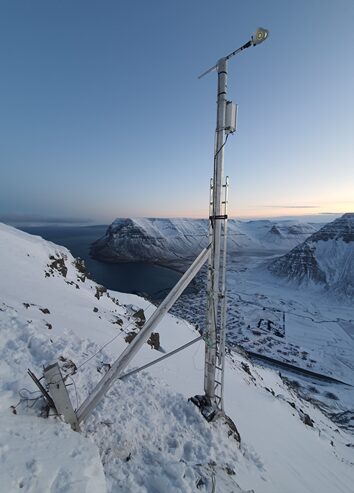How a maintenance-free sensor is changing snow monitoring.
July 23, 2025

This interview with Christoph Sommer, Sommer Messtechnik of Austria has been edited for clarity and brevity.
Snow is beautiful but it’s also powerful. From feeding freshwater reservoirs to triggering avalanches, snowpack can be both resource and risk. Yet for years, professionals in hydrology, meteorology, and infrastructure planning have struggled with one stubborn problem: how to measure snow depth accurately, consistently, and with as little maintenance as possible—especially in remote or extreme conditions.
We recently caught up with Christoph Sommer, head of R&D at Sommer Messtechnik, whose team has helped pioneer some of the most advanced snow measurement technology in use today. The maintenance-free USH-9 snow depth sensor —deployed from alpine research stations to remote weather networks across multiple continents — has earned a strong reputation for delivering accurate data in even the harshest conditions. Increasingly, it’s becoming a trusted tool for agencies and organizations across North America to strengthen winter monitoring and climate resilience strategies. In this conversation, we explore the thinking behind the sensor’s design, use in the field, and global collaborations with KISTERS to deliver real-time, integrated solutions across hydrology, meteorology, and environmental monitoring.

Q: Why is snow depth data so crucial right now? What are professionals struggling with most?
A: Snow is the canary in the coal mine when it comes to environmental balance. It reflects solar radiation, regulates temperature, feeds our rivers, and shapes the timing of everything from agricultural planning to flood forecasts. But collecting that data in real-time — without interruptions from ice, signal noise, or maintenance needs — has been a real hurdle, especially in remote or mountainous areas. Many legacy sensors require regular upkeep or can’t distinguish between falling snow and accumulated depth. That’s a huge issue for those who rely on live data to make decisions, like avalanche teams or water managers trying to estimate snowmelt volume for spring runoff.
Q: What makes the USH-9 different from other snow depth sensors on the market?
A: The USH-9 is designed to be something you install and forget about — in the best way. It’s maintenance-free. There are no membranes to swap out and no regular servicing needed. That’s rare in this space. It also handles temperature compensation internally, so even at -40°C or in fluctuating conditions, the data remains precise.
The sensor uses ultrasonic signal transit time to calculate snow depth, and a built-in processor filters out precipitation interference. So you’re not getting false positives when snow is still falling. We also added the ability to differentiate between snow and rain, which helps in applications like road weather monitoring or snow settling analysis.

Q: That sounds useful beyond just snow science. Who’s actually using this kind of technology?
A: Our customers are incredibly diverse. We work with national weather services, avalanche control programs, water resource managers, highway departments, and researchers studying climate resilience. The USH-9 fits into the larger picture of hydromet monitoring networks.
For example, whether you’re operating in the Alps or North American Rockies, getting someone on-site to service a snow sensor mid-season can be logistically impossible. With the USH-9, data keeps flowing without intervention. That’s a huge operational benefit.
Q: What are the big “aha” moments when professionals first deploy the USH-9?
A: People are usually surprised by how quickly it integrates into their systems and how little configuration is needed. It doesn’t need a heating element to operate. And it directly outputs the final snow depth value, so there’s no need to do post-processing or filtering on the backend.
They also appreciate the low total cost of ownership (TCO). Because it’s maintenance-free and durable, you’re not burning budget on upkeep or replacements. For budget-constrained agencies with few personnel, that’s a real differentiator.
Q: You mentioned climate change. How does that shift the importance of snow data?
A: Snow patterns are changing: more rain-on-snow events, unpredictable accumulation, shorter snow seasons. The uncertainty makes real-time, reliable snow data essential. It’s not just about monitoring what’s there, but being able to model what’s coming – floods, water scarcity, even infrastructure stress from freeze-thaw cycles.
We’re seeing is a move toward smarter, leaner sensing infrastructure. You can’t throw more people at the problem. You need tools that work autonomously, adapt to conditions, and feed directly into decision systems. That’s where we believe sensors like the USH-9 make a real impact.
Q: Looking ahead, how do you see maintenance-free snow monitoring changing the way we understand and respond to our changing climate?
A: We’re moving toward a world where environmental monitoring becomes truly autonomous and ubiquitous. The USH-9 represents a fundamental shift from thinking about sensors as equipment that need constant care to thinking about them as permanent infrastructure — like having a weather station that works reliably for decades.
This opens up possibilities we couldn’t consider before: continent-spanning networks that provide real-time snow data from thousands of remote locations, AI-driven systems that can detect climate pattern changes as they happen, and early warning systems that protect communities months in advance instead of days.
The ultimate vision is that decisions about water, safety, and climate adaptation become based on comprehensive, real-time data rather than estimates and guesswork. When you can monitor everywhere that matters, you can protect what matters most.
KISTERS is proud to be the exclusive U.S. distributor of Sommer snow measurement instrumentation, a trusted partnership that spans more than a decade. Built for the realities of extreme weather and remote terrain, the USH-9 delivers precise, continuous snow depth data when and where it matters most. For agencies responsible for flood forecasting, avalanche mitigation, and managing snowmelt as a critical part of the water cycle, it’s not just another sensor, it’s a decisive tool in turning winter data into year-round resilience.
We invite you to learn more about the USH-9 snow depth sensor, explore other snow sensing instruments or contact our team.